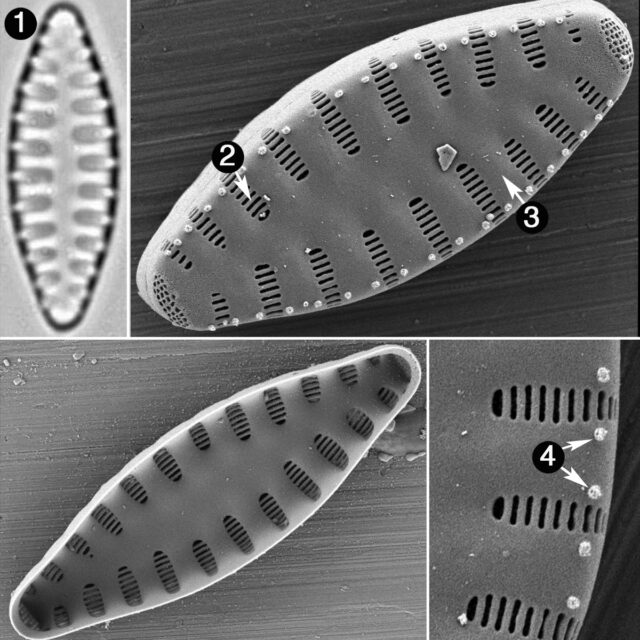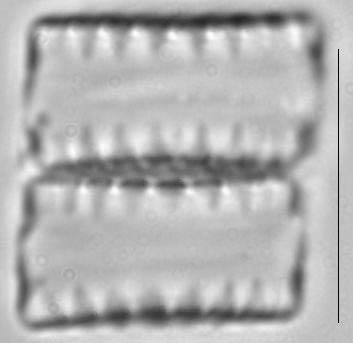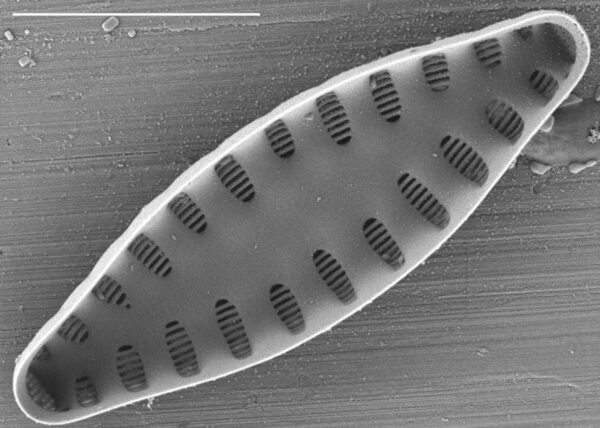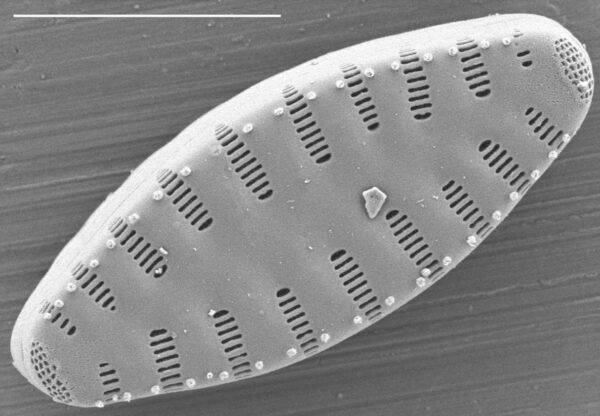Staurosirella leptostauron var. dubia
-
Category
-
Length Range4-38 µm
-
Width Range3.5-6.5 µm
-
Striae in 10 µm6-10
-
SynonymsFragilaria leptostauron var. dubia (Grunow) Hust.
-
ContributorEduardo A. Morales - Oct 2010
-
ReviewerSarah Spaulding - Feb 2011
Identification
Description
Valves are heavily silicified, lanceolate in larger specimens and elliptical in smaller specimens, 3.5-6.5 µm wide by 4-38 µm long. Valves demonstrate rostrate ends in larger specimens becoming rounded in smaller valves. Valve face flat, or slightly undulate due to raised costae. The valve face/mantle junction forms a sharp angle. The abvalvar edge of the mantle is parallel to the valve face/mantle junction. In girdle view, frustules are rectangular and form ribbon-like colonies, probably joined by linking spines. The colonies are attached to the substratum at one end by a frustule attached by a mucilage pad, or colonies may be planktonic. The axial area is lanceolate. The striae are distinct, composed of lineolae gradually decreasing in size from the valve face/mantle edge to both the central sternum and the valve mantle, 6-10 in 10 µm. The lineolae bear finely branched volae. Lineolae are long forming wide striae that have the appearance of punch holes on the valve. Striae vary from parallel in the central area to radiate toward the valve ends. Striae extend deeply into the valve mantle. Costae are wider than the striae. The spines are reduced to solid prominences, two on each costa, between the striae. Striae are present along the valve face edge, except at the apices. Well-developed, ocellulimbus type, apical pore fields with round poroids are present. Apical pore fields are located on the valve mantle. Rimoportula are absent. Scab-like structures, or blisters, are absent. Copulae, or girdle bands are open and do not bear perforations. Valvocopula are wider than other girdle elements and bear developed fimbriae (finger-like projections).
Autecology
Frustules attach to substrates by mucilage pads; ribbon-like colonies are common.
-
Size Range, µm3
-
Motility
-
Attachment
-
Habitat
-
Colony
-
Waterbody
-
Distribution
- Learn more about this
Citations & Links
Citations
Links
-
Index Nominum Algarum
-
North American Diatom Ecological DatabaseNADED ID: 175007
Cite This Page
Morales, E. (2010). Staurosirella leptostauron var. dubia. In Diatoms of North America. Retrieved April 18, 2024, from https://diatoms.org/species/staurosirella_leptostauron_var._dubia
Responses
The 15 response plots show an environmental variable (x axis) against the relative abundance (y axis) of Staurosirella leptostauron var. dubia from all the stream reaches where it was present. Note that the relative abundance scale is the same on each plot. Explanation of each environmental variable and units are as follows:
ELEVATION = stream reach elevation (meters)
STRAHLER = distribution plot of the Strahler Stream Order
SLOPE = stream reach gradient (degrees)
W1_HALL = an index that is a measure of streamside (riparian) human activity that ranges from 0 - 10, with a value of 0 indicating of minimal disturbance to a value of 10 indicating severe disturbance.
PHSTVL = pH measured in a sealed syringe sample (pH units)
log_COND = log concentration of specific conductivity (µS/cm)
log_PTL = log concentration of total phosphorus (µg/L)
log_NO3 = log concentration of nitrate (µeq/L)
log_DOC = log concentration of dissolved organic carbon (mg/L)
log_SIO2 = log concentration of silicon (mg/L)
log_NA = log concentration of sodium (µeq/L)
log_HCO3 = log concentration of the bicarbonate ion (µeq/L)
EMBED = percent of the stream substrate that is embedded by sand and fine sediment
log_TURBIDITY = log of turbidity, a measure of cloudiness of water, in nephelometric turbidity units (NTU).
DISTOT = an index of total human disturbance in the watershed that ranges from 1 - 100, with a value of 0 indicating of minimal disturbance to a value of 100 indicating severe disturbance.

Staurosirella leptostauron var. dubia
- Valves lanceolate to elliptical
- Areolae lineolate
- Costae wider than striae
- Spines reduced, two per costae
Valves of S. leptostauron var. dubia are lanceolate to elliptical with rounded ends in smaller specimens. The distinct, broad striae are composed of lineolate areolae. Costae tend to be wider than striae. Spines are solid and reduced compared to other Staurosirella taxa. Two spines are present for each costa.
 Diatoms of North America
Diatoms of North America








